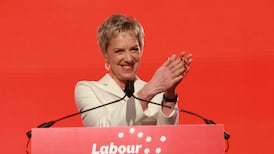A campaign to unsquash the poor “squeezed middle” is a top feature in any pre-budget brood of kites. So no surprises there.
What is slightly more surprising is the early contender proposed by three junior Fine Gael ministers. That’s the one advocating a €1,000 tax cut to “give the squeezed middle” a break. But the big surprise is how vague that targeting is.
This of course is precisely why junior ministers, lobbyists, any old member of the public and my dozy cat should feel free to put any budget proposal out there for discussion to any media prepared to publish them. What’s not to like about everyone having a punt about possibly life-changing decisions made on their behalf – including a ministerial triad looking particularly fired up about any of them?
What the triad gets in return – because they’re politicians – is not gratitude for their care and enthusiasm but a thorough public evisceration/sober analysis/grudging approval, which is precisely what every kite requires, before vanishing into the bubble of policy shapers, legislators and possible oblivion.
I split the family home with my daughter. Here’s what the Government needs to do
With its big, ridiculous mistake, the BBC played into the hands of an authoritarian liar
Anti-woke Ivan Yates must have seemed the obvious choice to toughen Jim Gavin up
Where are the patriots protesting when Irish men are the ones carrying out assaults?
[ Miriam Lord: Kite-flying season begins with ChatFGTD solo-runOpens in new window ]
Yet there is something diverting about a bunch of junior ministers – which includes one, Jennifer Carroll MacNeill, who actually serves in the Department of Finance – turning to the media to extract concessions from the Minister for Finance, a man whose ear is available to their leadership and them all day every day. Diverting and a bit odd.
Add the fact that the soaraway October budget is still four months out and the actual Minister for Finance, Michael McGrath has already had to deny he was being “bullied” over tax breaks and it’s hardly surprising that some Fine Gael supporters are watching all this from behind the sofa.
Regardless of the party’s (true) protestations that cuts were always in the programme for Government – eg tax credits and bands would be index-linked to earnings – this particular kite is notable for its low-flying ambition and sky-high attention-seeking. It feels unnecessarily provocative, and that makes the troops nervous.
So which desirable group is it aimed at exactly?
That would be the “squeezed middle”, a cohort that every political party ardently needs and courts, so Fine Gael’s targeting appears to makes perfect sense. But who is this “squeezed middle” exactly?
The difference in this year’s rite of kites is not just the near-mystical €65 billion pot but the fact that it drops into an atmosphere lightly leavened with election fever
The short answer is they don’t earn enough to be well off, but earn too much to qualify for many State supports. If that description doesn’t quite capture their essence it’s because the label is in the eye of the beholder, as one analyst puts it; everyone thinks they’re “squeezed” and everyone thinks they’re “middle”.
Last year Sinn Féin’s Pearse Doherty referred to “workers in the squeezed middle” as “those earning €35,000 or less…”. Social Justice Ireland defines “middle” as a single PAYE worker earning €40,000. In their budget models, accountants Grant Thornton see “squeezed middle income” as a family of four with two earners on a combined income of €90,000.
Ruth Coppinger, former Socialist Party TD summarises it thus: “The ‘squeezed middle’ is primarily workers, but it’s a term used by establishment to try divide working class people between low paid/those who must claim social welfare v[ersus] better-paid workers. We are all part of the working class, provide our labour for a wage”.
And the actual answer? According to 2021 CSO statistics, the true middle earner in Ireland earns €33,540 a year – which makes Doherty the quiz winner. Crucially, the same batch of figures showed that only about a third of earners were on more than €45,000 a year which may surprise some. And this is the problem with the proposed €1,000 tax break for the “squeezed middle”. By these measures, it’s the €45,000-plus earners who would see the full €1,000 tax cut proposed by the triad, not the real middle who earn €10,000 less. In short, the triad’s proposal would primarily benefit the top third to a quarter of earners rather than actual middle earners.
As for the couples who match the Grant Thornton model of “squeezed middle income”, well, happy days. A pair with combined earnings that puts them in the top 10 per cent of taxpayers would be particular beneficiaries of the proposed scheme. And while they may well feel “squeezed” – and with reason, says the analyst – they can hardly be described as the “middle” of anything.
Which brings us back to Fine Gael’s targeting and what it tells us about their election strategy so far. The difference in this year’s rite of kites is not just the near-mystical €65 billion pot, but the fact that it drops into an atmosphere lightly leavened with election fever. At such times, the visceral urge for all politicians is to put clear blue water between themselves and other parties – which is happening and which carries the danger of descending into even more panicky division and insultingly transparent auction politics.
The limp FG kites already in flight suggest the party’s ambitions are limited to hunkering down with their 20-25 per cent core vote and talking only to them. It smacks of fatigue and surrender.
None of this is to diminish low/middle-income battles with the cost of living, coupled with all the well-documented infrastructural and service inadequacies. There’s nothing wrong with a nice tax cut – but let’s be clear about who benefits and why.
Above all let’s hope that somewhere beneath the kite-flying and within department walls, some properly transformative plans are gaining currency, ready to astonish us with the boldness of their scale and imagination.














